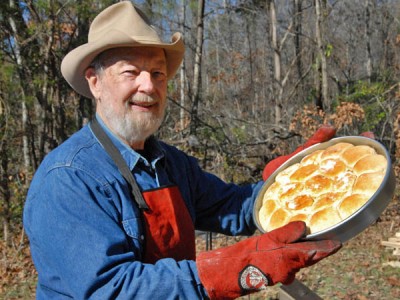
J. Wayne Fears wrote the book on Dutch oven cooking. Well, one of them at least. He’s the author of The Complete Book of Dutch Oven Cooking. Fears grew up on Tater Knob Mountain in northern Alabama. His dad harvested and sold ginseng, in addition to trapping, hunting and fishing – like the original mountainmen and survivalists. During his early years, J. Wayne Fears followed along behind his dad and learned how to survive in the wilderness. At college, Fears got a degree in forest recreation and has been an outdoor writer for more than 40 years. Dutch oven cooking was a natural way of life for the Fears family.
To cook with a Dutch oven, you set it in the coals of a fire and put coals on the lid to give this one pot the ability to bake, stew or boil almost any kind of food – just as the early pioneers did. Dutch ovens were a staple as frontiersmen moved from the East to the West on wagon trains and into cattle country. All the cooking for the cowboys was done over open fires. The Dutch oven and a frying pan were often the only utensils that the chuck wagon chefs carried with them. With the availability of gas and electric ranges, ovens, microwaves and convection ovens these days, the Dutch oven isn’t nearly as much of a necessity as it once was. But there are still many campers and outdoorsmen who enjoy cooking over open fires. Some folks even enjoy cooking in a Dutch oven in the fireplaces at their homes. Let’s take a step back into yesteryear, and learn about an old and fun way to cook that you can enjoy on your next camping trip.
 J. Wayne Fears’ Cowboy Cathead Biscuits in a 12-inch Dutch Oven (makes 7)
J. Wayne Fears’ Cowboy Cathead Biscuits in a 12-inch Dutch Oven (makes 7)
Ingredients:
- 1 cup flour
- 1-1/2 teaspoons baking powder
- 1-1/2 teaspoons sugar
- 1/8 teaspoon salt
- 1/2 cup butter
- 1/3 cup milk or buttermilk
Preparation:
Stir together flour, baking powder, sugar and salt. Cut in butter, until mixture resembles coarse bread crumbs. Make a well in the middle of the mixture, and stir in the milk or the buttermilk. Knead on a floured surface a few times, but work the dough as little as possible to keep the dough from becoming tough. Roll dough to a 1/2 inch thickness. Cut with a 2 inch cutter. Transfer the biscuits to an aluminum pan in a Dutch oven and cook in hot coals. Bake at 450 degrees for 10–12 minutes.
To learn more about cooking in a Dutch oven, you can buy Fears’ book from www.skyhorsepublishing.com.
If you like these cathead biscuits, give Fears’ venison stew and his navy beans a try.
Check out this video on the biscuits below.
httpv://youtu.be/PokO8YBiPvY

 Your Privacy Choices
Your Privacy Choices
 The
The